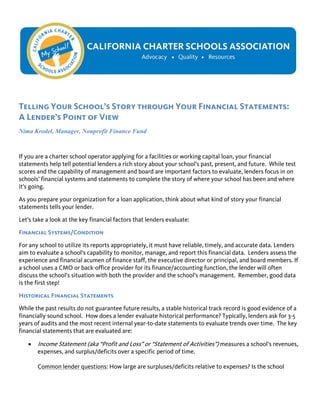
Telling Your School’s Story through Your Financial Statements: A Lender’s Point of View
- 1. Telling Your School’s Story through Your Financial Statements: A Lender’s Point of View Nima Krodel, Manager, Nonprofit Finance Fund If you are a charter school operator applying for a facilities or working capital loan, your financial statements help tell potential lenders a rich story about your school’s past, present, and future. While test scores and the capability of management and board are important factors to evaluate, lenders focus in on schools’ financial systems and statements to complete the story of where your school has been and where it’s going. As you prepare your organization for a loan application, think about what kind of story your financial statements tells your lender. Let’s take a look at the key financial factors that lenders evaluate: Financial Systems/Condition For any school to utilize its reports appropriately, it must have reliable, timely, and accurate data. Lenders aim to evaluate a school’s capability to monitor, manage, and report this financial data. Lenders assess the experience and financial acumen of finance staff, the executive director or principal, and board members. If a school uses a CMO or back-office provider for its finance/accounting function, the lender will often discuss the school’s situation with both the provider and the school’s management. Remember, good data is the first step! Historical Financial Statements While the past results do not guarantee future results, a stable historical track record is good evidence of a financially sound school. How does a lender evaluate historical performance? Typically, lenders ask for 3-5 years of audits and the most recent internal year-to-date statements to evaluate trends over time. The key financial statements that are evaluated are: • Income Statement (aka “Profit and Loss” or “Statement of Activities”) measures a school’s revenues, expenses, and surplus/deficits over a specific period of time. Common lender questions: How large are surpluses/deficits relative to expenses? Is the school
- 2. saving? If so, is it enough for current and future debt service? In terms of costs, are expenses in line with revenue changes? If needed, can a school cut back on variable expenses? What are the school’s unrestricted revenue dynamics (local, state, federal government revenue versus contributed support)? Are revenues consistent and reliable, year after year? • Balance Sheet (aka “Statement of Position”) represents your assets, liabilities and net assets on a particular date. Common lender questions: Are the size, nature and distribution of your capital structure appropriate to support the school over the long term? Is there enough cash available to cover current obligations? How quickly can receivables convert to cash? How liquid are a school’s net assets? Is the school facility or debt intensive? Has the balance sheet changed over time and if so, why? Forward-Looking Financial Statements These statements tell the school’s “plan” for the future. They can indicate enrollment growth, fundraising efforts, facilities projects, or cash flow planning. Depending on the loan request, a lender will request any or all of the following documents to learn about the future: • Budgets tell the school’s plan for the following year in terms of revenue and expenses. Keep in mind, the budget is not a static document; the budget should be compared to year-to-date figures and amended as needed throughout the year. Common lender questions: What are enrollment and attendance projections? Are per pupil revenue rates appropriately calculated? Are expenses in line with revenues? Is the budget conservatively estimated, given the unpredictable nature of government cuts? What is the school’s contingency plan for reducing expenses if enrollment estimates are not met or state funding is cut mid-year? • Cash flow projections enable management to estimate how much cash it should keep on hand based on projected cash inflows and outflows over a period of time. The projections also help indicate the tough months during which the organization may need access to short-term debt. Given delays in government payments, schools must be vigilant monitoring on a monthly or even weekly basis. Remember there is a difference between CASH FLOW needs (timing of receipts and payments) and CASH needs (overall cash shortage). Common lender questions: When is the school’s cash position the lowest? Does the cash flow projection mirror the state’s payment schedule? If government payments are delayed, can the school cover the cash flow gap? Does the school have or need a line of credit to bridge payment delays?
- 3. • Income Statement Projections forecast revenues and expenses over a number of years. Often long- term projections are required if a school is embarking on a growth trajectory and/or facilities project. Common lender questions: Do projected surpluses cover future debt payments? Is debt repayment contingent on growth or additional fundraising? Are projections realistic? Can the projections be “stress-tested” in terms of enrollment growth, per pupil reimbursement rates, and expenses? Other Financial or Project Data Depending on the loan request, a lender may require other relevant financial information. For example, if a school is dependent on fundraising, a lender may ask for a list of past funders for recent years. If a school is embarking on a facilities project, lenders may request project budgets, sources and uses, and construction schedules. If your school already has debt, a lender may ask for a schedule of all debt and repayment history. Tell Your School’s Story During these difficult times, clearly articulating your school’s financial story is critical to obtaining a loan. Just as lenders peel back the layers of your school’s financial statements, ask yourself the same questions and see how you would assess your own schools’ financial circumstance. More than ever, understanding and being able to interpret the numbers to tell your story will ensure good financial management and long-term sustainability of your school.
